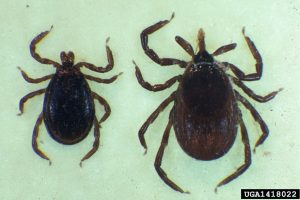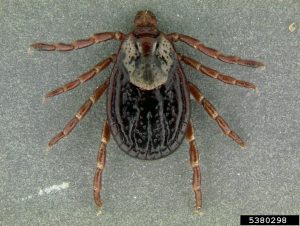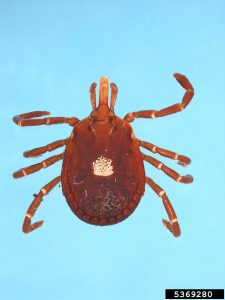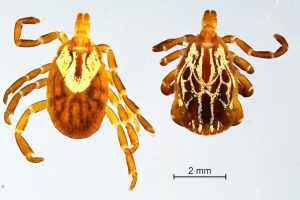The Gulf Coast Tick Carries Another Virus of Concern
Anecdotal evidence suggests that 2020 has been a banner year for ticks, but experts say that 2021 will likely be worse. The wet weather of the past few months has extended the habitat of many tick species and introduced a new species to Illinois—the Gulf Coast tick. And, as if the Coronavirus pandemic isn’t bad enough, the Lone Star tick in Illinois can now carry and transmit Heartland virus.
Many of us have heard of or been affected by tick diseases—namely Lyme disease, Rocky Mountain spotted fever and Ehrlichiosis. Then there are the more rare occurrences of babesiosis and anaplasmosis. Now we are faced with additional tick-borne illnesses Tidewater spotted fever and Heartland virus.
Lyme disease is caused by two main species of bacteria in the United States, Borrelia burgdorferi and Borrelia mayonii, and is transmitted by the bite of an infected black-legged tick, commonly known as a deer tick.

Early symptoms of Lyme disease include: From three to 30 days after an infected tick bite, an expanding red area might appear that sometimes clears in the center, forming a bull’s-eye pattern. The rash expands slowly over days and can spread to 12 inches across. It’s typically not itchy or painful but might feel warm to the touch. The rash is one of the hallmarks of Lyme disease, although not everyone with Lyme disease develops the rash. Some people develop this rash at more than one place on their bodies. Other symptoms include fever, chills, fatigue, body aches, headache, neck stiffness and swollen lymph nodes can accompany the rash.
Later symptoms include: Bouts of severe joint pain and swelling which are especially likely to affect your knees, but the pain can shift from one joint to another. Weeks, months or even years after infection, you might develop inflammation of the membranes surrounding your brain (meningitis), temporary paralysis of one side of your face (Bell’s palsy), numbness or weakness in your limbs, and impaired muscle movement.
Rocky Mountain spotted fever is caused by the bacterium Rickettsia rickettsii (R Rickettsii), which is carried and transmitted by the bite of the dog tick in the eastern United States.

Early signs and symptoms of Rocky Mountain spotted fever include a severe headache and high fever, but can also include chills, muscle aches, nausea and vomiting. A few days later, a rash usually appears on the wrists and ankles. The red, nonitchy rash associated with Rocky Mountain spotted fever typically appears three to five days after the initial signs and symptoms begin. The rash usually makes its first appearance on your wrists and ankles, and can spread in both directions — down into the palms of your hands and the soles of your feet, and up your arms and legs to your torso. Some people who are infected with Rocky Mountain spotted fever don’t ever develop a rash, which makes diagnosis much more difficult. However, Rocky Mountain spotted fever responds well to prompt treatment with antibiotics.
Ehrlichiosis is caused by Ehrlichia bacteria and is transmitted primarily by the Lone Star tick.

If a tick carrying the bacterium that causes ehrlichiosis has been feeding on you for at least 24 hours, the following flu-like signs and symptoms may appear — usually within seven to 14 days of the bite: mild fever, headache, chills, muscle aches, nausea, vomiting, diarrhea, fatigue, loss of appetite, joint pain, confusion, rash, or cough. Some people infected with ehrlichiosis may have symptoms so mild that they never seek medical attention and the body fights off the illness on its own, but untreated ehrlichiosis with persistent symptoms can result in an illness serious enough to require hospitalization. Ehrlichiosis responds well to prompt treatment with antibiotics.
Babesiosis is a rare and life-threatening infection of the red blood cells caused by tiny parasites called Babesia microti spread by the bite of the deer tick.
Signs of babesiosis start one to eight weeks after you come in contact with the parasite that causes the disease. Sometimes you won’t notice any symptoms, but if you do, they might include: body aches, chills, fatigue, fever, headache, loss of appetite and sweating. Symptoms can be worse if you are elderly, no longer have your spleen or have a health condition or take medications that weaken your immune system. Treatment may include a drug that kills microorganisms along with an antibiotic.
Anaplasmosis is an illness caused by the bacteria Anaplasma phagocytophilum which is spread by the bite of a deer tick.
The illness can cause fever, chills, muscle aches, nausea, vomiting, cough, fatigue, rash and confusion. Older adults and people with compromised immune systems are more likely to have severe symptoms. Antibiotics are the main course of treatment.
Heartland virus is an emerging pathogen that has been found in Lone Star ticks in two Illinois counties hundreds of miles apart.
The symptoms of Heartland virus include: fever, nausea, diarrhea, headache, fatigue and decreased appetite.
Tidewater spotted fever is an illness caused by the pathogen Rickettsia parkeri and is transmitted by the bite of a new tick to our area, the Gulf Coast tick.

The Gulf Coast tick is usually found in the Southeast along the Gulf and Atlantic coasts, however there is evidence that is it becoming established in Illinois. Director of the Illinois Natural History Survey medical entomology program, Chris Stone, and vector ecologist, Holly Tuten, say that the Gulf Coast tick likely originally made its way to Illinois thanks to migratory birds that picked up the ticks during their travels south during the winter months.
With Illinois’ average winter temperatures rising, the state could become hospitable to the Gulf Coast tick. It has been documented in 14 counties across Illinois, including St. Clair.
Symptoms for Tidewater spotted fever include: fever, muscle aches, headaches and a rash. Tidewater spotted fever is similar to, but not as severe as, Rocky Mountain spotted fever. Both of these tick-transmitted diseases can be treated with an antibiotic.
As you can see, most tick-borne illnesses have many of the same symptoms, which makes a particular diagnosis difficult. To complicate matters, these symptoms overlap with some of COVID-19. Blood tests for tick-borne illnesses commonly include Lyme disease, Rocky Mountain spotted fever and Ehrlichiosis, but not babesiosis or anaplasmosis. Many physicians are not even aware of the Heartland virus or Tidewater spotted fever. If you have symptoms listed under any of these tick-borne illnesses it would be wise to apprise your doctor of the location of your outdoor activities and any noted or possible tick bites.
CLIFFTOP, a local nonprofit organization, is focused on preserving and protecting area bluff lands.
A version of this article appeared in the August 21, 2020 edition of the Monroe County Indpendent.
©2020 all content rights reserved Clifftop NFP
Comments are currently closed.
